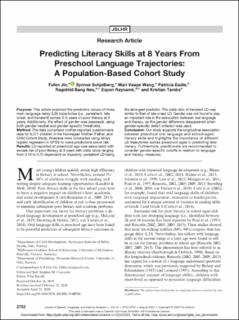| dc.contributor.author | Jin, Fufen | |
| dc.contributor.author | Schjølberg, Synnve | |
| dc.contributor.author | Wang, Mari Vaage | |
| dc.contributor.author | Eadie, Patricia | |
| dc.contributor.author | Nes, Ragnhild Bang | |
| dc.contributor.author | Røysamb, Espen | |
| dc.contributor.author | Tambs, Kristian | |
| dc.date.accessioned | 2023-05-08T10:00:23Z | |
| dc.date.available | 2023-05-08T10:00:23Z | |
| dc.date.created | 2020-08-13T10:32:57Z | |
| dc.date.issued | 2020 | |
| dc.identifier.citation | Journal of Speech, Language and Hearing Research. 2020, 63 (8), 2752-2762. | |
| dc.identifier.issn | 1092-4388 | |
| dc.identifier.uri | https://hdl.handle.net/11250/3066741 | |
| dc.description.abstract | Purpose This article explored the predictive values of three main language delay (LD) trajectories (i.e., persistent, late onset, and transient) across 3-5 years on poor literacy at 8 years. Additionally, the effect of gender was assessed, using both gender-neutral and gender-specific thresholds. Method The data comprised mother-reported questionnaire data for 8,371 children in the Norwegian Mother, Father, and Child Cohort Study. Analyses were conducted using binary logistic regression in SPSS to make predictions about risk. Results LD reported at preschool age was associated with excess risk of poor literacy at 8 years with odds ratios ranging from 3.19 to 9.75 dependent on trajectory, persistent LD being the strongest predictor. The odds ratio of transient LD was similar to that of late-onset LD. Gender was not found to play an important role in the association between oral language and literacy, as the gender difference disappeared when gender-specific deficit criterion was used. Conclusion Our study supports the longitudinal association between preschool oral language and school-aged literacy skills and highlights the importance of different LD trajectories across preschool ages in predicting later literacy. Furthermore, practitioners are recommended to consider gender-specific cutoffs in relation to language and literacy measures. | |
| dc.language.iso | eng | |
| dc.title | Predicting Literacy Skills at 8 Years From Preschool Language Trajectories: A Population-Based Cohort Study | |
| dc.type | Peer reviewed | |
| dc.type | Journal article | |
| dc.description.version | publishedVersion | |
| dc.source.pagenumber | 2752-2762 | |
| dc.source.volume | 63 | |
| dc.source.journal | Journal of Speech, Language and Hearing Research | |
| dc.source.issue | 8 | |
| dc.identifier.doi | 10.1044/2020_JSLHR-19-00286 | |
| dc.identifier.cristin | 1823114 | |
| dc.relation.project | Norges forskningsråd: 288083 | |
| cristin.ispublished | true | |
| cristin.fulltext | original | |
| cristin.qualitycode | 2 | |
